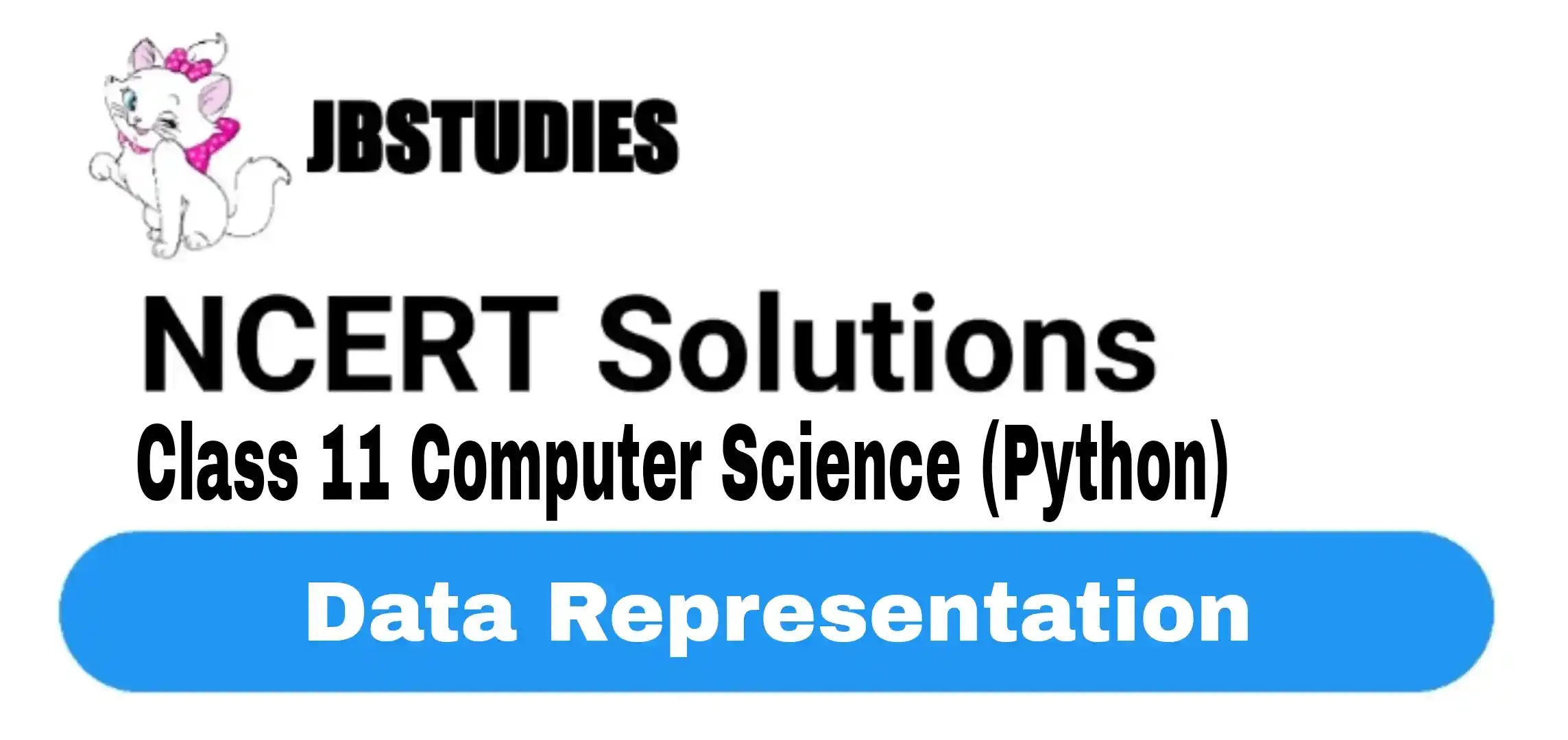NCERT Solutions Class 11 Computer Science (Python) Chapter-3 (Data Representation)
Class 11 Computer Science (Python)
Chapter-3 (Data Representation)
Questions and answers given in practice
Chapter-3 (Data Representation)
TOPIC 1
Number System and Its Conversion
Short Answer Type Questions-IIQuestion 1:
Explain octal and hexadecimal number.
Answer:
Octal (base 8) was previously a popular choice for representing digital circuit numbers in a form that is more compact than binary. Octal is sometimes abbreviated as oct. Octal counting goes as :
0,1, 2, 3,4, 5, 6, 7,10,11,12,13,14,15,16,17,20, 21 and so on.
Hexadecimal (base 16) is currently the most popular choice for representing digital circuit numbers in a form that is more compact than binary. Hexadecimal numbers are sometimes represented by preceding the value with ‘Ox’, as in 0x1 B84. Hexadecimal is sometimes abbreviated as hex. Hexadecimal counting goes :
0,1,2, 3,4,5, 6, 7, 8,9, A, B, C, D, E, F, and so on. 3
Question 2:
Explain decimal and binary number.
Answer:
Decimal (base 10) is the way most human beings represent numbers. Decimal is sometimes abbreviated as dec. Decimal counting goes :
0,1,2,3,4,5,6,7,8,9,10,11,12,13,14,15,16,17,18 and so on.
Binary (base 2) is the natural way most digital circuits represent and manipulate numbers. Binary numbers are sometimes represented by preceding the value with ‘Ob’, as in Ob1O11. Binary is sometimes abbreviated as bin.
Binary counting goes as : 0,1,10,11,100,101,110,
111, 1000, 1oo1, 1010,1011, 11oo, 1101, 1110, 1111,10000,10001 and so on. 3
Question 3:
Convert (259)10 to binary form.
Answer:%20Chapter-3%20(Data%20Representation)%20(3).webp)
Therefore : (259)10 =(100000011)2.
Question 4:
Convert (17.35)10 to binary form.
Answer:%20Chapter-3%20(Data%20Representation)%20(1).webp)
Now we have to convert the fractional part, that means the part after decimal:%20Chapter-3%20(Data%20Representation)%20(2).webp)
Question 5:
Convert (39286)10 to octal form.
Answer:%20Chapter-3%20(Data%20Representation)%20(8).webp)
(39286)10 = (114566)8
Question 6:
Convert (0.2)10 to the binary form.
Answer:%20Chapter-3%20(Data%20Representation)%20(9).webp)
(0.2)10= (0.0011)2
Question 7:
Convert (423.03125)10 to octal form.
Answer:%20Chapter-3%20(Data%20Representation)%20(10).webp)
Question 8:
Fill the correct entry. 3
| Decimal | Binary | Octal |
| 0 | 000 | 0 |
| 1 | 001 | 1 |
| 2 | ? | 2 |
| 3 | Oil | 3 |
| 4 | 100 | 4 |
| 5 | 101 | 5 |
| ? | 110 | 6 |
| 7 | ? | ? |
Answer:
| Decimal | Binary | Octal |
| 0 | 000 | 0 |
| 1 | 001 | 1 |
| 2 | 010 | 2 |
| 3 | Oil | 3 |
| 4 | 100 | 4 |
| 5 | 101 | 5 |
| 6 | 110 | 6 |
| 7 | 111 | 7 |
Question 1:
Do as directed :
(a) Convert the Decimal number 781 to its Binary equivalent.
(b) Convert Binary number 101101.001 to its decimal equivalent.
(c) Convert Octal number 321.7 into its Binary equivalent.
Answer:%20Chapter-3%20(Data%20Representation)%20(6).webp)
Question 2:
Do as directed :
(a) Covert the Hexadecimal number 3BC into its Binary equivalent
(b) Convert the Binary number 10011010.010101 to its Hexadecimal equivalent.
(c) Convert the Decimal number 345 into Octal number.
Answer:%20Chapter-3%20(Data%20Representation)%20(7).webp)
Question 3:
Do as directed
(a) Convert the Decimal number 736 into Hexadecimal number.
(b) Convert the Octal number 246.45 into Hexadecimal number.
(c) Convert the Hexadecimal number ABF.C into Octal number.
(d) Covert the Octal number 576 to Decimal.
(e) Convert the Hexadecimal number A5C1 to Decimal,
Topic-2
Internal Storage Encoding Of Characters
Short Answer Type Questions-II
Question 1:
What is ASCII ?
Answer:
It is acronym for the American Standard Code for Information Interchange. It is used in most microcomputers and minicomputers and in many mainframes. It is a 7-bit code so it has 27 = 128 possible code groups. 2
Question 2:
What is ISCII ?
Answer:
It is acronym for Indian Standard Code for Information Interchange. It is a 8-bit code so it has 28 = 256 possible code groups. It retains all ASCII characters and offers codng for Indian characters also. 2
Question 3:
What do you understand by Unicode ?
Answer:
It is the new universal coding standard being adopted all newer platforms. Unicode provides a unique number for every character, no matter what the platform or program or the language is. 2
Question 4:
Expand the following:
1. ASCII
2. ISCII
Answer:
- ASCII: American Standard Code for Information Interchange.
- ISCII : Indian Standard Code for Information Interchange. 2
NCERT Solutions for Class 11 Computer Science (Python) PDF
Unit 1 : Computer Fundamentals
Unit 2 : Programming Methodology
Unit 3 : Introduction to Python
- 7. Introduction to Python
- 8. Getting Started with Python
- 9. Operators in Python
- 10. Functions
- 11. Conditional and Looping Constructs
Unit 4 : Programming with Python

%20Chapter-3%20(Data%20Representation)%20(5).webp)
%20Chapter-3%20(Data%20Representation)%20(4).webp)









